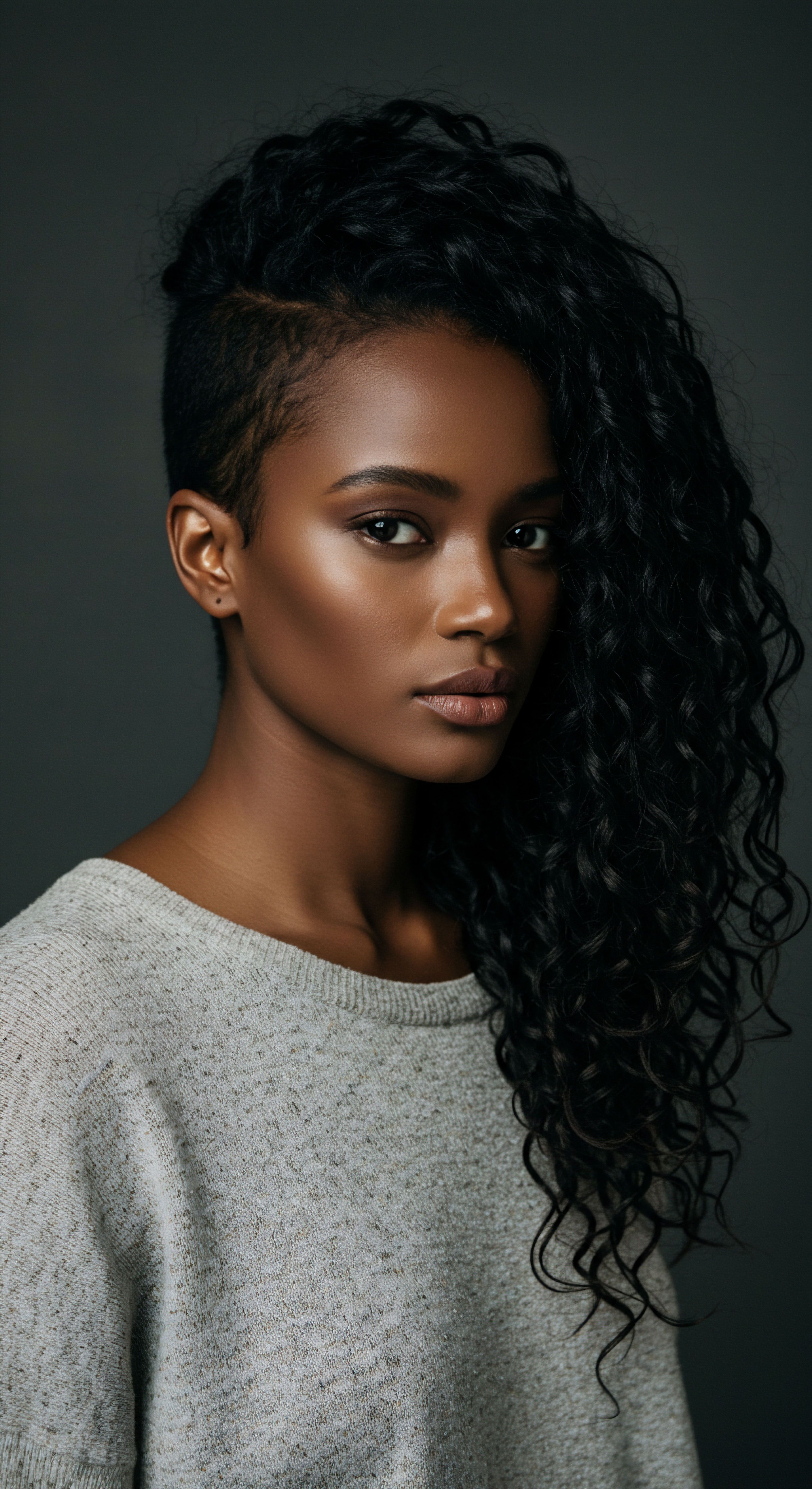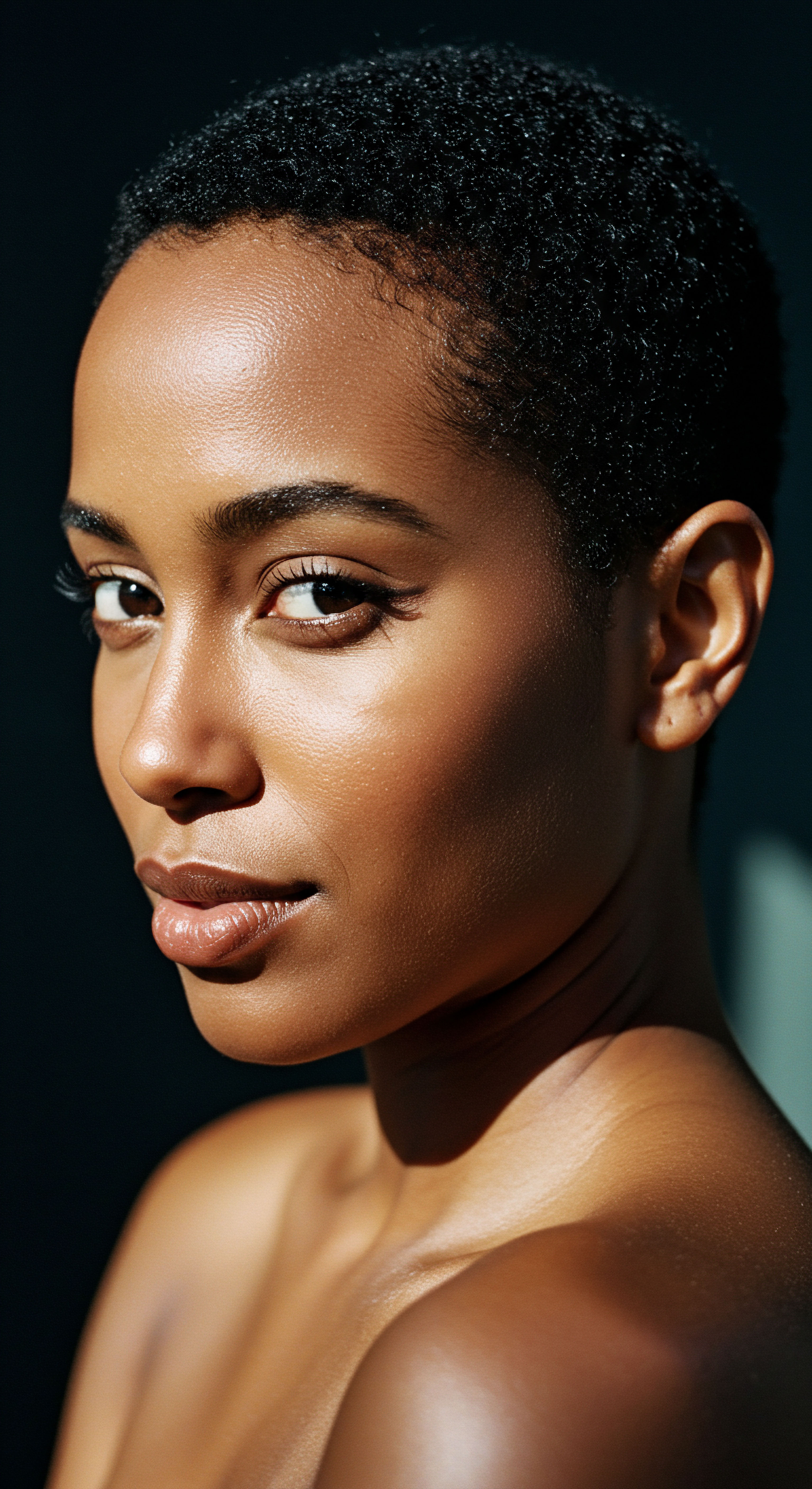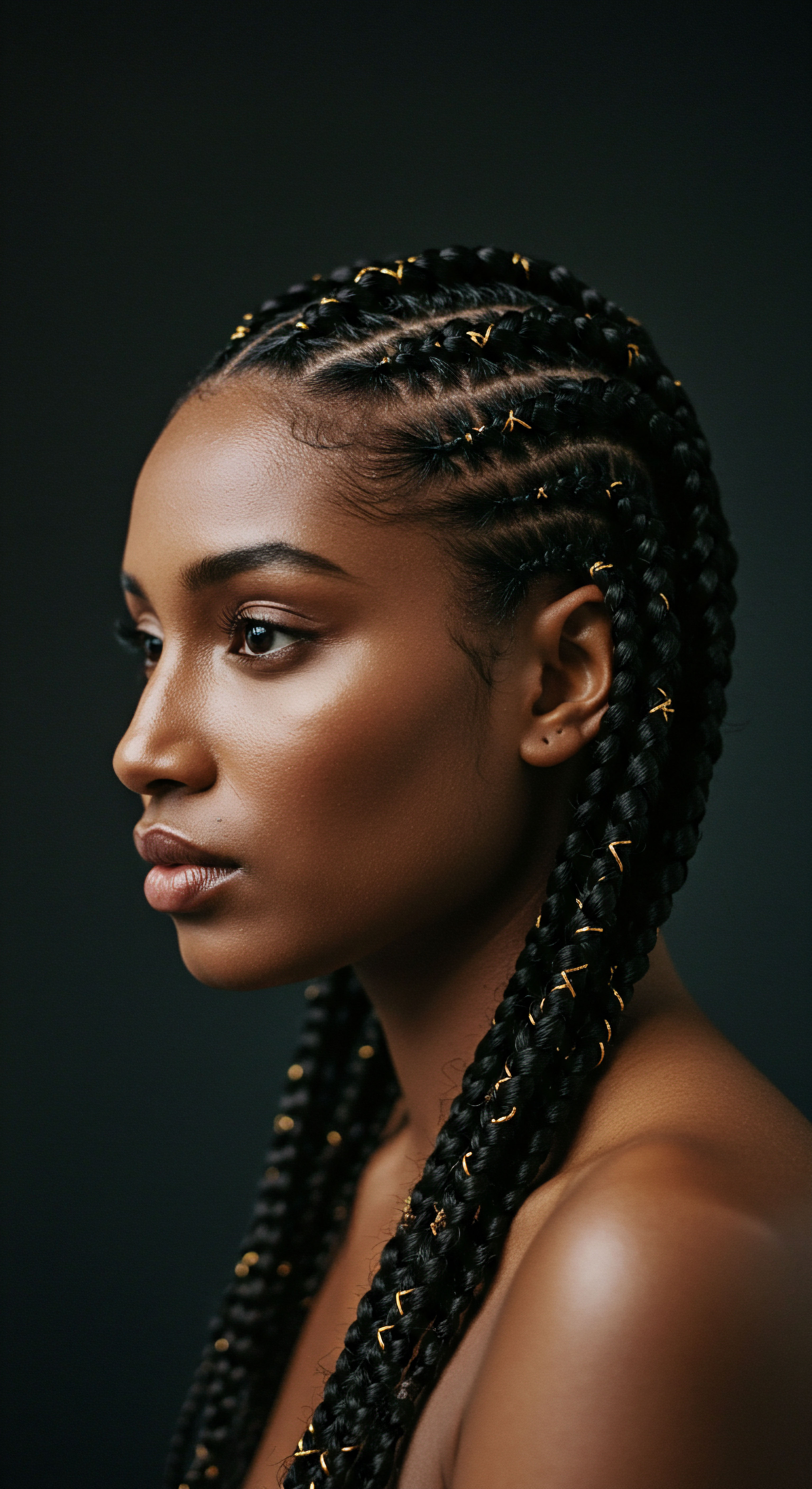
Roots
The very ground beneath our hair, the scalp, holds secrets to its vitality, often whispered in the gentle rustle of leaves or the quiet hum of an ancient song. We seldom pause to consider the intricate ecosystem dwelling there, the delicate balance that fosters life for each strand. Yet, beneath the surface, a subtle force, scalp tension, can stir ripples that reach far into the cycles of hair growth, influencing its journey from emergence to release. This exploration seeks to understand these quiet movements, connecting the scientific workings of our scalp to the living experiences of our hair, particularly for those with textured strands, where ancestral wisdom often reminds us of this profound connection.

The Scalp’s Living Architecture
Our scalp is far more than just skin; it represents a complex, multi-layered environment, a foundation for hair. It comprises five distinct layers, remembered by the simple word SCALP ❉ Skin, Connective Tissue, Epicranial Aponeurosis, Loose Areolar Connective Tissue, and Pericranium. The outermost skin layer, thick and rich with hair follicles and sebaceous glands, sits atop a dense connective tissue layer, housing a network of blood vessels and nerves. This connective tissue connects the skin to the epicranial aponeurosis, a strong, immobile layer.
Beneath this lies a loose areolar connective tissue, allowing some movement between the upper layers and the pericranium, which tightly adheres to the skull. This layered arrangement provides both protection and a dynamic environment for hair follicles.
Within the dermis, the middle layer of the skin, hair follicles anchor themselves, extending into the subcutaneous tissue below. Each follicle, a tubular structure of epithelial cells, culminates in a hair bulb that cradles the dermal papilla. This papilla, composed of connective tissue, holds tiny blood vessels and nerve projections, acting as a crucial communication center for hair growth.
The dermal papilla receives signals and nutrients, guiding the hair through its various phases. The health of this dermal environment, supported by collagen and elastin, directly impacts the hair’s quality and its ability to grow robustly.

The Rhythmic Dance of Hair Growth
Hair growth unfolds in a rhythmic, cyclical process, a silent dance with distinct phases. This cycle, repeated throughout our lives, determines the length, thickness, and vitality of each strand.
- Anagen Phase ❉ This is the active growth period, where hair cells rapidly divide and strands lengthen. For scalp hair, this phase can last from two to seven years, shaping the potential length of our hair.
- Catagen Phase ❉ A brief transitional period, lasting only a few weeks. During this time, hair growth ceases, and the hair follicle begins to shrink.
- Telogen Phase ❉ The resting phase, typically lasting a few months. Hair remains in the follicle, but no active growth occurs. At the end of this phase, the old hair is released.
- Exogen Phase ❉ The shedding phase, where the old hair falls out, making way for new growth from the same follicle, restarting the anagen phase.
A healthy scalp environment is essential for this cycle to proceed smoothly. Disruptions, whether from internal factors like hormones or external pressures, can alter the timing and duration of these phases, potentially leading to thinning or loss.
The scalp, a layered and dynamic foundation, orchestrates hair growth through intricate cycles.

When Tension Interrupts the Flow
Scalp tension, often an unacknowledged companion in our daily lives, can disrupt this delicate hair growth rhythm. This tension arises from various sources, including tight hairstyles, prolonged stress, or even unconscious muscle clenching. When the muscles surrounding the scalp, such as the occipitofrontalis, tighten, they can exert mechanical stress across the scalp’s surface.
This sustained pressure can lead to several consequences for the hair follicles. It may restrict blood flow to the scalp, diminishing the delivery of vital oxygen and nutrients that hair follicles require for robust growth. Reduced circulation means the hair follicles are less nourished, potentially shortening the anagen (growth) phase and prompting hairs to enter the resting or shedding phases prematurely.
Consider the findings from a 2016 study published in Eplasty, which demonstrated that Standardized Scalp Massage Increased Hair Thickness in a small group of men over 24 weeks. The researchers proposed that the mechanical stretching induced by the massage stimulated dermal papilla cells, leading to changes that supported thicker hair growth. This suggests a direct link between mechanical manipulation of the scalp and follicular activity, implying that chronic, unyielding tension might have the opposite, detrimental effect by constricting rather than stimulating.
Moreover, chronic tension can contribute to inflammation in the scalp. Inflammation can further disrupt the hair growth cycle, damaging follicular cells and altering the scalp’s microenvironment, making it less conducive to healthy hair production. The scalp, like any other part of our being, responds to persistent pressure, and its well-being is deeply connected to the vibrant expression of our hair.

Ritual
To move beyond mere existence and truly thrive, our hair, particularly textured strands, asks for more than fleeting attention; it asks for a conscious ritual. This section guides us through the practical wisdom and thoughtful practices that can alleviate scalp tension, fostering an environment where hair can grow freely, without the invisible chains of strain. We step into a space of shared knowledge, where techniques and methods are explored with gentle guidance, recognizing that every touch, every product choice, and every moment of care contributes to the overall vitality of our crown.

Daily Practices for Scalp Serenity
The daily and weekly choices we make for our hair significantly influence scalp tension. Understanding how common styling practices and product applications interact with the scalp’s delicate ecosystem can transform our routine into a supportive ritual.
One of the most direct sources of scalp tension arises from certain hairstyles. Styles that involve tight pulling, such as very taut braids, cornrows, ponytails, or weaves, place continuous mechanical stress on hair follicles. This constant tugging can irritate nerve endings and even cause inflammation around the follicle.
Over time, this sustained pressure can lead to a condition known as Traction Alopecia, a form of hair loss characterized by thinning or bald patches along the hairline or areas of highest tension. The follicular damage and eventual scarring associated with prolonged tension highlight the importance of mindful styling.

Does Scalp Massage Really Help Hair Growth?
A gentle, consistent scalp massage can be a profound ritual for relieving tension and encouraging healthy hair growth. This practice, rooted in ancient traditions across various cultures, stimulates blood circulation to the scalp. Improved circulation ensures that hair follicles receive an ample supply of oxygen and nutrients, essential building blocks for hair production.
Beyond blood flow, scalp massage can also mechanically stretch the dermal papilla cells, which are critical for hair cycle regulation. Research, such as the 2016 study on scalp massage and hair thickness, points to this mechanical stimulation as a potential mechanism for influencing hair growth. Furthermore, the act of massage itself can reduce stress hormones and blood pressure, contributing to overall well-being, which in turn benefits hair health.
To begin a scalp massage ritual:
- Preparation ❉ Start with clean hands. You may use a lightweight oil, like jojoba or a blend designed for scalp health, to reduce friction and provide additional nourishment.
- Technique ❉ Use the pads of your fingertips, not your nails. Apply gentle to medium pressure, moving in small, circular motions across your entire scalp. Pay particular attention to areas that feel tense, such as the temples, crown, and nape.
- Duration ❉ Aim for 5-10 minutes daily. Consistency is more important than intensity. Even a few minutes can make a difference.
This simple yet powerful practice can become a grounding moment, a connection to the living wisdom of your own body and the traditions that celebrate hair as a sacred aspect of self.
Mindful styling and regular scalp massage are essential practices for alleviating tension and fostering hair vitality.

Tools and Products to Support Scalp Health
The marketplace offers a range of tools and products that can assist in managing scalp tension and supporting hair growth. Selecting those that align with gentle care and genuine benefit is key.
| Tool Fingertips |
| Primary Benefit Direct pressure control, sensory feedback. |
| Consideration for Textured Hair Always available, precise for sensitive areas. |
| Tool Scalp Massagers (manual/electric) |
| Primary Benefit Consistent pressure, increased circulation. |
| Consideration for Textured Hair Choose soft silicone bristles to avoid snagging delicate strands. |
| Tool Wide-Tooth Combs |
| Primary Benefit Gentle detangling, reduces pulling. |
| Consideration for Textured Hair Essential for minimizing mechanical tension during styling. |
| Tool Selecting tools that respect the hair's integrity is crucial for long-term scalp health. |
When it comes to products, look for formulations that prioritize scalp health. Ingredients that calm inflammation, hydrate the skin, and support cellular function are beneficial.
- Soothing Scalp Serums ❉ These often contain ingredients like aloe vera, chamomile, or calendula, known for their calming properties. They can reduce irritation and dryness, which often contribute to scalp discomfort.
- Lightweight Oils ❉ Natural oils such as argan, jojoba, or sweet almond oil can be used for scalp massages. They provide slip, allowing for gentle manipulation without excessive friction, and offer nourishing compounds.
- Gentle Cleansers ❉ Shampoos free from harsh sulfates can help maintain the scalp’s natural moisture balance, preventing dryness and tightness. Regular, yet gentle, cleansing helps remove product buildup and excess sebum that can clog follicles and contribute to irritation.
The goal is to create a regimen that supports the scalp’s innate ability to maintain health, rather than fighting against perceived problems. This thoughtful approach allows the hair to flourish from a truly balanced and serene foundation.

Relay
As we delve deeper into the intricate relationship between scalp tension and hair growth cycles, we discover a convergence of biological mechanisms, psychological states, and even ancestral echoes. The query “How does scalp tension affect hair growth cycles?” expands beyond simple cause and effect, inviting us into a sophisticated understanding where scientific discovery meets the enduring wisdom of cultural practices. This section aims to provide a profound understanding, drawing upon scholarly insights and research to illuminate the subtle, yet powerful, ways tension can reshape the very landscape of our hair.

The Biomechanics of Scalp Tension and Follicular Response
The scalp’s connective tissue, particularly the galea aponeurotica, plays a role in transmitting mechanical forces to the hair follicles. This dense layer, continuous with the occipitofrontalis muscle, can become a conduit for tension. Sustained tension in these muscles, whether from chronic stress, certain facial expressions, or even postural habits, translates into physical strain on the underlying scalp tissue.
This mechanical stress is not merely superficial. It can influence the microenvironment of the hair follicle at a cellular level. Research suggests that mechanical stimulation, or the lack thereof, can impact the behavior of dermal papilla cells. These cells, nestled at the base of the hair follicle, are crucial for signaling and activating hair follicle stem cells, which drive new hair growth.
A compelling area of study points to the role of the Dermal Sheath, a smooth muscle surrounding hair follicles. Scientists at Mount Sinai discovered that this muscle contracts during the regression phase (catagen) of the hair cycle, physically relocating dermal papilla cells to interact with stem cells in the upper follicle. Manipulating this contraction could potentially stall the hair cycle’s regression phase, preventing the loss of existing hair. This implies that chronic tension, by altering the natural mechanics of the scalp and potentially interfering with the dermal sheath’s function, could disrupt this delicate cellular dance, impacting the anagen phase’s duration and overall hair production.
Beyond direct mechanical interference, chronic tension can also contribute to a state of low-grade inflammation within the scalp. Inflammatory mediators can impair the proliferation of keratinocytes, the cells responsible for forming the hair shaft, and prematurely force follicles into the telogen phase. This persistent inflammatory environment, a silent consequence of unresolved tension, can undermine the scalp’s ability to sustain robust hair growth.

Can Hormonal Responses to Stress Influence Scalp Health?
The body’s physiological response to stress, often manifesting as scalp tension, introduces a hormonal dimension to hair growth. When under stress, the body releases hormones like cortisol. Elevated cortisol levels can disrupt the balance of other hormones that regulate hair development, including androgens. This hormonal imbalance can lead to follicular miniaturization, a process where hair follicles gradually shrink, producing thinner, shorter hairs, eventually contributing to hair loss.
A significant study from Harvard University researchers, published in Nature in 2021, illuminated how chronic stress impacts hair follicle stem cells. They found that the stress hormone corticosterone (the rodent equivalent of human cortisol) prevents the dermal papilla from secreting GAS6, a molecule that activates hair follicle stem cells. This means prolonged stress, and the associated hormonal responses, can keep hair follicles in an extended resting phase, inhibiting new hair growth. This research offers a scientific basis for the observed link between stress-induced scalp tension and hair loss, showing a direct molecular pathway.
| Stress Factor Chronic Tension |
| Physiological Response Restricted blood flow, localized inflammation. |
| Effect on Hair Follicle Reduced nutrient supply, impaired cellular function. |
| Stress Factor Elevated Cortisol |
| Physiological Response Hormonal imbalance, reduced GAS6 secretion. |
| Effect on Hair Follicle Extended telogen phase, inhibited stem cell activation. |
| Stress Factor Psychological Stress |
| Physiological Response Increased muscle tightness, nervous system activation. |
| Effect on Hair Follicle Direct mechanical strain, potential for trichotillomania. |
| Stress Factor Stress, in its varied forms, can significantly alter the hair growth cycle through mechanical and biochemical pathways. |

Cultural Echoes and Holistic Well-Being
Across cultures, hair has long been revered, often serving as a symbol of identity, strength, and spiritual connection. Many traditions instinctively understood the connection between scalp health and overall well-being, incorporating practices that inherently addressed tension.
In India, the Ayurvedic practice of Shiro Abhyanga, or head oiling massage, is a centuries-old ritual. This involves warming botanical oils and massaging them into the scalp with slow, circular motions. This practice is believed to nourish the body, soothe the nervous system, and connect to spiritual calm. From a scientific perspective, such practices not only improve blood circulation to the scalp but also reduce physical tension and promote relaxation, mitigating the stress response that impacts hair growth.
Similarly, traditional Chinese medicine views scalp massages as a method to enhance qi (energy) flow, relieving tension and stimulating circulation. These practices, passed down through generations, highlight a deep, intuitive understanding that a relaxed scalp and a calm mind contribute to a flourishing crown.
The persistence of these cultural practices offers a powerful counterpoint to modern approaches, reminding us that true hair health extends beyond topical applications. It encompasses a mindful relationship with our bodies, acknowledging the subtle signals of tension and responding with care that is both scientific and soulful. The wisdom of these traditions, in their gentle rhythmic applications, provides a testament to the profound connection between internal serenity and external vibrancy.
The deep link between stress, hormones, and scalp tension directly impacts hair growth at a cellular level.

Reflection
As we draw this exploration to a close, the intricate dance between scalp tension and the cycles of hair growth reveals itself not as a simple equation, but as a deeply interwoven story of biology, lived experience, and enduring cultural wisdom. We have witnessed how the unseen pressures of daily life, whether from a tightly pulled style or the silent weight of stress, can ripple through the very foundation of our hair, altering its rhythm and expression. Yet, within this understanding lies a profound invitation ❉ to approach our hair, and indeed our whole selves, with a gentle hand and a knowing heart. The journey toward vibrant hair is a continuous unfolding, a dialogue between science and tradition, reminding us that care, in its truest form, is a conscious act of connection, allowing each strand to truly flourish.

References
- 1. Kim, K. Kobayashi, K. Hama, T. Murakami, K. & Ogawa, R. (2016). Standardized Scalp Massage Results in Increased Hair Thickness by Inducing Stretching Forces to Dermal Papilla Cells in Human Hair Follicles. Eplasty, 16, e8.
- 2. Trueb, R. M. (2009). The impact of scalp connective tissue on hair follicle cycling and disease. Dermatology, 218(3), 224-232.
- 3. Trueb, R. M. (2001). Traction alopecia. Seminars in Cutaneous Medicine and Surgery, 20(2), 121-125.
- 4. Gho, C. G. (2018). The effect of inflammation on hair growth and hair melanogenesis in man. Journal of Dermatology, 45(1), 3-8.
- 5. Kligman, A. M. (1959). The human hair cycle. Journal of Investigative Dermatology, 33(5), 307-314.
- 6. Biggs, L. C. Mignone, J. & Hsu, Y. C. (2020). Mechanical stress and hair follicle stem cells. Development, 147(24), dev194165.
- 7. Oh, J. W. Wang, E. H. & Zlotogorski, A. (2016). Hair follicle stem cells and their niches. Experimental Dermatology, 25(4), 251-258.
- 8. Lee, H. J. & Kim, Y. C. (2018). Stress and hair loss. International Journal of Dermatology, 57(10), 1167-1172.
- 9. Randall, V. A. (2008). Hormonal regulation of hair growth ❉ an update. Dermatology, 216(1), 17-32.
- 10. Fischer, T. W. Herczeg, A. & Hempel, B. (2012). The hair cycle and its control ❉ an overview. Dermatology, 224(4), 317-326.
- 11. Sato, S. & Yoshizato, K. (2019). Human scalp hair growth and scalp condition in relation to scalp massage. Journal of Physical Therapy Science, 31(1), 13-16.
- 12. Trüeb, R. M. & Dias, M. F. R. (2018). Hair Loss ❉ Medical and Surgical Management. CRC Press.
- 13. Rushton, D. H. (2002). Nutritional factors and hair loss. Clinical and Experimental Dermatology, 27(5), 396-404.
- 14. Headington, J. T. (1984). Telogen effluvium. Archives of Dermatology, 120(11), 1515-1516.
- 15. Olsen, E. A. (1999). Female pattern hair loss. Journal of the American Academy of Dermatology, 40(2), 231-240.